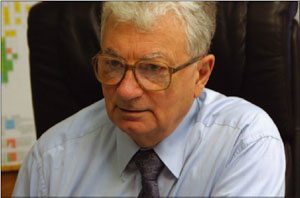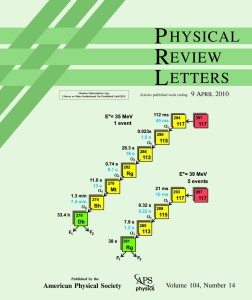ՀԵՌՈՒՍՏԱԾՐԱԳՐԵՐ - Հեղինակ՝ Admin. Wednesday, April 28, 2010 23:47 - 2 քննարկում
Armenian,Y u r i T s o l a k o v i c h O g a n e s s i a n discovered new chemical element number 117
On April 9, Yuri Tsolakovich Oganessian and his team of Russian and American physicists published a paper discussing their discovery of element number 117 in “Physical Review Letters.”
The team led by Oganessian of the Joint Institute for Nuclear Research in Dubna, Russia, discovered the still unnamed element by colliding together calcium-48 (an isotope made of 20 protons and 28 neutrons) with berkelium-249 (which has 97 protons and 152 neutrons). The result of the fusion reactions was the creation of two isotopes—293117 and 294117—of an element with 117 protons. One isotope had 176 neutrons, and the other had 177. “After experiment on the synthesis [of] element 118, this is the second time when we [were able to produce] atomic nuclei with mass number 294,” Oganessian told the Armenian Weekly.
Number 117 is a superheavy element. Such superheavies tend to decay fast, almost immediately. They do not exist in nature, and are created by colliding lighter elements together through particle accelerators. In fact, only the first 92 elements on the periodic table are natural. The first artificial elements were discovered in 1940-41—neptunium and plutonium—and by the end of the century a total of 17 artificial elements were discovered. Many researchers think that these superheavy elements could reach an “island of stability”; in other words, as their mass increases they could become more stable and have longer lifetimes. A press report issued by Oganessian’s team explains, “The decay properties of the isotopes of element 117 and its daughter products…are a direct experimental evidence of the existence of the ‘islands of stability’ of superheavy nuclei.”
For now the newly discovered element, which is positioned between elements 116 and 118 on the periodic table, is referred to as Ununseptium, which means 117 in Latin. It will receive an official name once the discovery is confirmed elsewhere. The name could pay homage to a laboratory or person involved in the discovery. Element 105, for example, was named Dubnium by the International Union of Pure and Applied Chemistry in honor of the Flerov Laboratory of Nuclear Reactions (FLNR) located in Dubna, Russia.
The Weekly asked Oganessian if he has any advice for the Armenian youth going into the scientific field. “I would wish to say [to] my young colleagues that scientific work is a hard labor,” said Oganessian. “Once you have chosen this way, let you be not depressed by the problem of eternal search, let you be not saddened by setbacks, and let you never lose self-confidence. Some time or other, the fruits of your effort will be called for and your name will be referred to with gratitude by your successors.”
Experimental physicist Yuri Oganessian, who will turn 77 on April 14, is well known for his work on the physics of the atomic nucleus and nuclear reactions, and experiments on the synthesis and investigations on the properties of new elements on the periodic table. He was born in 1933 in Rostov/Don in the then-Soviet Union. After graduating from the Moscow Engineering Physics Institute in 1956, he joined the Joint Institute for Nuclear Research in Dubna where he became head of the accelerator start-adjusting group, and then director and scientific leader of FLNR. After defending his theses in 1970, he became a professor and a Full Member of the Russian Academy of Sciences (RAS). He has formulated the basic principles of synthesis of transfermium elements in the reactions of cold fusion, and with the help of his colleagues, conducted experiments on the synthesis of elements with Z=100-108. Between 1999 and 2006, these reactions resulted in the discovery of elements with Z=113-116, and 118, which is the largest atomic number discovered so far. He is also head of the “Experimental Methods in Nuclear Physics” branch chair of the Moscow Engineering Physics Institute, and chairman of the Dissertation Council in Dubna.
Oganessian’s work has been recognized with numerous awards and honors, including the USSR State Prize (1975), the I.V. Kurchatov Prize (USSR AS, 1989), the G.N. Flerov Prize (JINR, 1993), the A. von Humboldt Prize (Germany, 1995), the L. Meitner Prize (European Physical Society, 2000), and the MAIK Nauka/Interperiodika Prize (2001). He has also earned a number of governmental awards, such as the Order of the Red Banner of Labour, the Order for Service to the Fatherland fourth degree (1999), the Order for Service to the Fatherland third degree (2003), and the Order of Friendship of Peoples. He has been on the editorial boards of the Journal of Physics, Nuclear Physics News International, Il Nuovo Cimento, Physics of Elementary Particles and Atomic Nuclei, and Particle Accelerators. He is a member of the Scientific Councils of GANIL (France) and RIKEN (Japan), and has been elected a foreign member of the Serbian Academy of Sciences and Arts (1995), honorary doctor of the Goethe University (Frankfurt/Main, Germany, 2002), and the University of Messina (Italy, 2002).
Oganessian has provided the Armenian Weekly with a detailed description of the experiment that led to the discovery of heaviest element with atomic number 117.
http://www.armenianweekly.com/2010/04/16/oganessian/?utm_source=feedburner&utm_medium=feed&utm_campaign=Feed:+ArmenianWeekly+%28Armenian+Weekly%29
2 քննարկումներ
Anush


